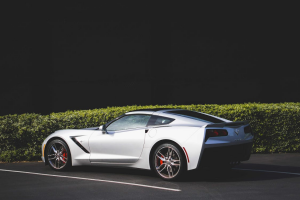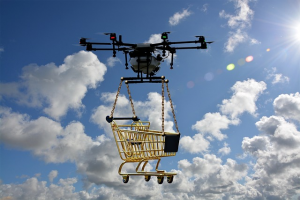
Unmanned Aerial Vehicles (UAVs), commonly known as drones, have evolved from military reconnaissance tools to versatile devices used in various sectors. Initially, drones were primarily developed for military and surveillance purposes, but over the past few decades, advancements in technology have propelled them into civilian applications such as agriculture, filmmaking, logistics, and environmental monitoring. This article explores the history, technological advancements, and future prospects of drone technology, shedding light on how these airborne devices are reshaping industries and society as a whole.

Chapter 1: The History and Early Development of Drones
1.1 Origins of UAV Technology
The concept of unmanned flight dates back to the early 20th century. The first UAVs were simple, radio-controlled aircraft designed for target practice in military training exercises. In the 1930s, a series of early drones, known as “Radioplane,” were developed by actor and inventor Walter R. LaBerge. These devices were crude by today’s standards but represented the first step in the evolution of UAV technology.
1.2 Drones in Military Applications
The role of drones in warfare became increasingly significant during World War II. The use of UAVs for surveillance and reconnaissance during the conflict marked the beginning of their military potential. Post-World War II, the U.S. military and various other countries invested heavily in developing UAVs for intelligence, surveillance, and reconnaissance (ISR) missions, as well as for targeted strikes.
1.3 Technological Advances in the 20th Century
Throughout the Cold War and into the 1980s, UAV technology continued to advance, driven primarily by military needs. The development of GPS systems, improved communications technology, and more efficient propulsion systems led to greater precision and range. These developments laid the groundwork for the drones we see today.
Chapter 2: The Rise of Commercial and Civilian Drones
2.1 Early Civilian Uses
By the late 1990s, the potential for drones to be used beyond the military was realized. Early civilian applications included scientific research, environmental monitoring, and aerial photography. In the early 2000s, the development of smaller, more affordable drones made them accessible to a broader audience.
2.2 Drones in Filmmaking and Photography
The ability of drones to capture high-definition aerial footage revolutionized the film industry. Filmmakers embraced drones as an alternative to helicopters, allowing for dynamic, cost-effective shots that were previously impossible or too expensive to achieve. This led to the rapid adoption of drones by both professional and amateur photographers.
2.3 The Agricultural Revolution
In agriculture, drones have been increasingly used for crop monitoring, pest control, and precision farming. Drones allow farmers to survey large areas of land quickly and efficiently, identifying issues such as irrigation problems, soil health, and pest infestations. This has enabled farmers to reduce costs, increase crop yields, and make more informed decisions.
Chapter 3: The Technology Behind Modern Drones
3.1 Key Components of a Drone
Modern drones are complex systems that rely on a combination of hardware and software to operate efficiently. The main components include:
- Airframe: The structure that supports all the components, typically made from lightweight materials like carbon fiber.
- Propulsion System: Includes motors, propellers, and the power supply (usually batteries).
- Flight Controller: The brain of the drone, responsible for stabilization, navigation, and control.
- GPS and Sensors: Provide real-time data for navigation and obstacle avoidance.
- Cameras and Payloads: Many drones are equipped with high-resolution cameras and sensors, enabling them to capture visual and other data.

3.2 Advances in AI and Autonomy
Artificial intelligence and machine learning have played a critical role in making drones more autonomous. Today’s drones can perform complex tasks like obstacle avoidance, automatic route planning, and real-time data analysis. AI-powered drones are capable of adapting to changing environments, making them valuable tools for search and rescue, agriculture, and environmental monitoring.
3.3 Battery Life and Power Efficiency
One of the major challenges faced by drones is limited battery life. However, advances in battery technology, such as lithium-polymer (LiPo) batteries, have significantly improved flight times. Additionally, the development of more energy-efficient motors and power management systems has helped extend operational ranges and durations.
Chapter 4: Applications of Drones in Various Industries
4.1 Drones in Logistics and Delivery
One of the most talked-about applications of drones in recent years is their potential use in logistics and delivery. Companies like Amazon and UPS are exploring drone delivery systems that could dramatically reduce shipping times and costs. Drones are especially useful for delivering small packages in urban or rural areas where traditional delivery methods are slower or less efficient.
4.2 Drones in Disaster Response and Search-and-Rescue Operations
Drones have proven invaluable in emergency situations, such as natural disasters and search-and-rescue missions. Their ability to quickly survey affected areas and provide real-time data has allowed first responders to make better-informed decisions. Drones equipped with thermal imaging cameras, for example, can locate missing persons in search-and-rescue operations.
4.3 Drones in Environmental Conservation
Environmental scientists use drones for monitoring wildlife, tracking deforestation, and assessing the impact of climate change. Drones are an essential tool for conservationists, enabling them to gather data from hard-to-reach locations, such as dense forests or remote islands, without disturbing fragile ecosystems.
Chapter 5: Regulatory and Ethical Challenges
5.1 Airspace Regulation and Safety Concerns
As drones become more prevalent, there are growing concerns over airspace regulation and the potential for collisions with manned aircraft. In response, governments around the world have begun to implement regulations to ensure the safe integration of drones into national airspace systems. The Federal Aviation Administration (FAA) in the U.S. and the European Union Aviation Safety Agency (EASA) have set standards for drone operation, but challenges remain in creating universally accepted guidelines.

5.2 Privacy and Security Issues
The use of drones for surveillance has raised concerns about privacy. With the ability to fly over private property and capture high-resolution images and videos, drones could be used to infringe on personal privacy. Governments, companies, and individuals must navigate the balance between the benefits of drone technology and the protection of civil liberties.
5.3 Ethical Implications of Autonomous Drones
As drones become more autonomous, questions arise about accountability and decision-making. For example, in military applications, drones that are capable of performing targeted strikes raise ethical concerns about the potential for mistakes or misuse. Similarly, autonomous drones in civilian contexts could lead to unintended consequences if not properly regulated.
Chapter 6: The Future of Drone Technology
6.1 Technological Trends and Innovations
The future of drones is promising, with several exciting developments on the horizon. Some of the most anticipated innovations include:
- Swarming Technology: Drones could work together in coordinated groups, performing complex tasks more efficiently.
- 5G and Connectivity: The rollout of 5G networks will improve the communication capabilities of drones, enabling real-time data transmission and remote operation over longer distances.
- Hybrid and Solar-Powered Drones: Researchers are developing drones that combine traditional battery power with solar energy or hybrid propulsion systems to increase flight duration.
6.2 Drones in Urban Air Mobility
The concept of Urban Air Mobility (UAM) is gaining traction, with the idea of using drones or small aircraft to transport people and goods within cities. This includes autonomous air taxis and passenger drones that could ease traffic congestion and provide a more sustainable form of urban transportation.
6.3 Ethical and Regulatory Future
As drone technology continues to evolve, ethical and regulatory issues will remain critical areas of focus. Governments and organizations must continue to work together to create frameworks that ensure the safe and responsible use of drones while fostering innovation.
Drones have come a long way since their early military applications, and their growth shows no signs of slowing down. From transforming industries like agriculture and filmmaking to revolutionizing logistics and environmental monitoring, drones are proving to be one of the most influential technological innovations of the 21st century. While challenges in regulation, privacy, and ethics remain, the future of drones promises to be as exciting as their past has been transformative. As we look ahead, drones will continue to shape the way we interact with the world, opening up new possibilities and opportunities across various sectors.






